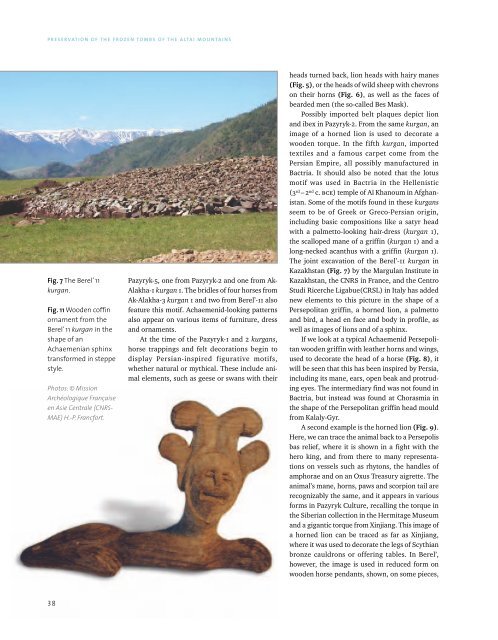Scythian Culture - Preservation of The Frozen Tombs of The Altai Mountains (UNESCO)
You also want an ePaper? Increase the reach of your titles
YUMPU automatically turns print PDFs into web optimized ePapers that Google loves.
PRESERVATION OF THE FROZEN TOMBS OF THE ALTAI MOUNTAINS<br />
Fig. 7 <strong>The</strong> Berel’ 11<br />
kurgan.<br />
Fig.11Wooden c<strong>of</strong>fin<br />
ornament from the<br />
Berel’ 11 kurgan in the<br />
shape <strong>of</strong> an<br />
Achaemenian sphinx<br />
transformed in steppe<br />
style.<br />
Photos: © Mission<br />
Archéologique Française<br />
en Asie Centrale (CNRS-<br />
MAE) H.-P. Francfort.<br />
Pazyryk-5, one from Pazyryk-2 and one from Ak-<br />
Alakha-1 kurgan 1. <strong>The</strong> bridles <strong>of</strong> four horses from<br />
Ak-Alakha-3 kurgan 1 and two from Berel’-11 also<br />
feature this motif. Achaemenid-looking patterns<br />
also appear on various items <strong>of</strong> furniture, dress<br />
and ornaments.<br />
At the time <strong>of</strong> the Pazyryk-1 and 2 kurgans,<br />
horse trappings and felt decorations begin to<br />
display Persian-inspired figurative motifs,<br />
whether natural or mythical. <strong>The</strong>se include animal<br />
elements, such as geese or swans with their<br />
heads turned back, lion heads with hairy manes<br />
(Fig. 5), or the heads <strong>of</strong> wild sheep with chevrons<br />
on their horns (Fig. 6), as well as the faces <strong>of</strong><br />
bearded men (the so-called Bes Mask).<br />
Possibly imported belt plaques depict lion<br />
and ibex in Pazyryk-2. From the same kurgan, an<br />
image <strong>of</strong> a horned lion is used to decorate a<br />
wooden torque. In the fifth kurgan, imported<br />
textiles and a famous carpet come from the<br />
Persian Empire, all possibly manufactured in<br />
Bactria. It should also be noted that the lotus<br />
motif was used in Bactria in the Hellenistic<br />
(3 rd –2 nd c. bce) temple <strong>of</strong> Aï Khanoum in Afghanistan.<br />
Some <strong>of</strong> the motifs found in these kurgans<br />
seem to be <strong>of</strong> Greek or Greco-Persian origin,<br />
including basic compositions like a satyr head<br />
with a palmetto-looking hair-dress (kurgan 1),<br />
the scalloped mane <strong>of</strong> a griffin (kurgan 1) and a<br />
long-necked acanthus with a griffin (kurgan 1).<br />
<strong>The</strong> joint excavation <strong>of</strong> the Berel’-11 kurgan in<br />
Kazakhstan (Fig. 7) by the Margulan Institute in<br />
Kazakhstan, the CNRS in France, and the Centro<br />
Studi Ricerche Ligabue(CRSL) in Italy has added<br />
new elements to this picture in the shape <strong>of</strong> a<br />
Persepolitan griffin, a horned lion, a palmetto<br />
and bird, a head en face and body in pr<strong>of</strong>ile, as<br />
well as images <strong>of</strong> lions and <strong>of</strong> a sphinx.<br />
If we look at a typical Achaemenid Persepolitan<br />
wooden griffin with leather horns and wings,<br />
used to decorate the head <strong>of</strong> a horse (Fig. 8), it<br />
will be seen that this has been inspired by Persia,<br />
including its mane, ears, open beak and protruding<br />
eyes. <strong>The</strong> intermediary find was not found in<br />
Bactria, but instead was found at Chorasmia in<br />
the shape <strong>of</strong> the Persepolitan griffin head mould<br />
from Kalaly-Gyr.<br />
A second example is the horned lion (Fig. 9).<br />
Here, we can trace the animal back to a Persepolis<br />
bas relief, where it is shown in a fight with the<br />
hero king, and from there to many representations<br />
on vessels such as rhytons, the handles <strong>of</strong><br />
amphorae and on an Oxus Treasury aigrette. <strong>The</strong><br />
animal’s mane, horns, paws and scorpion tail are<br />
recognizably the same, and it appears in various<br />
forms in Pazyryk <strong>Culture</strong>, recalling the torque in<br />
the Siberian collection in the Hermitage Museum<br />
and a gigantic torque from Xinjiang. This image <strong>of</strong><br />
a horned lion can be traced as far as Xinjiang,<br />
where it was used to decorate the legs <strong>of</strong> <strong>Scythian</strong><br />
bronze cauldrons or <strong>of</strong>fering tables. In Berel’,<br />
however, the image is used in reduced form on<br />
wooden horse pendants, shown, on some pieces,<br />
38
















